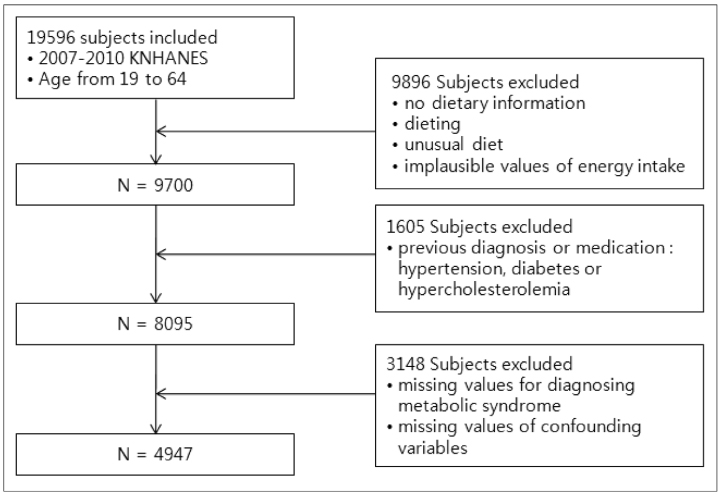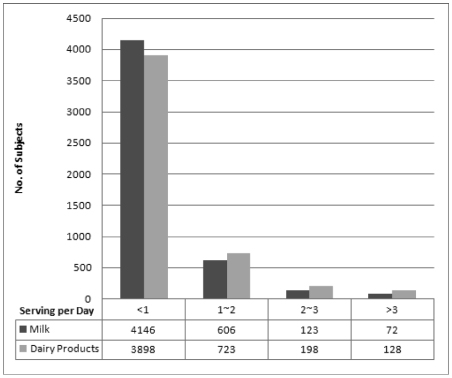Milk Intake is Associated with Metabolic Syndrome: Using Data from the Korea National Health and Nutrition Examination Survey 2007~2010
- Affiliations
-
- 1Graduate School of Public Health, Seoul National University, Korea. hjjoung@snu.ac.kr
- KMID: 2267470
- DOI: http://doi.org/10.5720/kjcn.2012.17.6.795
Abstract
- This study aimed to examine associations between milk intake and metabolic syndrome. The subjects included 1,928 males and 3,103 females, aged 19 to 64 years, from the data of 'The Korean National Health and Nutrition Survey 2007-2010'. Daily intake of milk and dairy products was obtained by a 24 hour dietary recall method and divided into two categories by equivalent weight of one serving. The average individual intakes of milk and dairy products were 59.4 g and 74.1 g per day respectively. Milk intake was inversely associated with metabolic syndrome (OR: 0.69, 95% CI: 0.54~0.89), central obesity (OR: 0.75, 95% CI: 0.62~0.91), and hypertriglyceridemia (OR: 0.73, 95% CI: 0.59~0.90). The total intake of dairy products was also inversely associated with metabolic syndrome (OR: 0.74, 95% CI 0.60~0.92), central obesity (OR: 0.73, 95% CI: 0.62~0.86), hypertension (OR: 0.80, 95% CI: 0.65~0.99). The association between intakes of milk and dairy products and metabolic syndrome was significant in women, but not in men. These results indicate that increased consumption of milk and its products is associated with a reduced likelihood of metabolic syndrome and metabolic syndrome risk factors. Further research on causal relationship and dose-response association between milk intake and metabolic syndrome risk is necessary prior to applying the observed results in nutrition policies and programs to prevent the metabolic syndrome.
MeSH Terms
Figure
Cited by 4 articles
-
Low consumption of fruits and dairy foods is associated with metabolic syndrome in Korean adults from outpatient clinics in and near Seoul
SuJin Song, Eun-Kyung Kim, Soyoung Hong, Sangah Shin, YoonJu Song, Hyun Wook Baik, Hyojee Joung, Hee Young Paik
Nutr Res Pract. 2015;9(5):554-562. doi: 10.4162/nrp.2015.9.5.554.Association between dairy product intake and hypertriglyceridemia in Korean adults
Seon-Joo Park, Junghyun Park, Hong Ji Song, Chang-Ho Lee, Hae-Jeung Lee
Nutr Res Pract. 2020;14(2):152-159. doi: 10.4162/nrp.2020.14.2.152.The Association between Dietary Fiber Intake and Prevalence of Metabolic Syndrome in Middle-aged Adults in Gyeonggi Province
You-Sin Lee, Sim-Yeol Lee
Korean J Health Promot. 2015;15(2):75-82. doi: 10.15384/kjhp.2015.15.2.75.Effects of a nutrition education program on metabolic syndrome risk factors in middle-aged Korean adults: an intervention study
Minji Kang, Young-Hee Park, Subeen Kim, Eunyoung Tak, Hyun Wook Baik, Hee Young Paik, Hyojee Joung
Korean J Community Nutr. 2024;29(4):265-277. doi: 10.5720/kjcn.2024.00005.
Reference
-
1. Astrup A, Dyerberg J, Elwood P, Hermansen K, Hu FB, Jakobsen MU, Kok FJ, Krauss RM, Lecerf JM, LeGrand P, Nestel P, Riserus U, Sanders T, Sinclair A, Stender S, Tholstrup T, Willett WC. The role of reducing intakes of saturated fat in the prevention of cardiovascular disease: where does the evidence stand in 2010? Am J Clin Nutr. 2011. 93:684–688.2. Berkey CS, Rockett HRH, Willett WC, Colditz GA. Milk, dairy fat, dietary calcium, and weight gain. Arch Pediatr Adolesc Med. 2005. 159:543–550.3. Biong AS, Veireod MB, Ringstad J, Thelle DS, Pedersen JI. Intake of milk fat, reflected in adipose tissue fatty acids and risk of myocardial infarction: a case-control study. Eur J Clin Nutr. 2006. 60:236–244.4. Dallongeville J, Cottel D, Ferrires J, Arveiler D, Bingham A, Ruidavets JB, Haas B, Ducimetire P, Amouyel P. Household income is associated with the risk of metabolic syndrome in a sex-specific manner. Diabetes Care. 2005. 28:409–415.5. Expert Panel on Detection, Evaluation, And Treatment of High Blood Cholesterol In Adults. Executive summary of the third report of the National Cholesterol Education Program (NCEP) Expert Panel on Detection, Evaluation, And Treatment of High Blood Cholesterol In Adults (Adult Treatment Panel III). JAMA. 2001. 285:2486–2497.6. Food and Agriculture Organization of the United Nations. The state of food and agriculture-livestock in the balance. 2009. cited 2012 Aug 29. Available from http://www.fao.org/docrep/012/i0680e/i0680e.pdf.7. German JB, Dillard CJ. Saturated Fats: A perspective from lactation and milk composition. Lipids. 2010. 45:915–923.8. German JB, Gibson RA, Krauss RM, Nestel P, Lamarche B, van Staveren WA, Steijns JM, de Groot L, Lock AL, Destailats F. A reappraisal of the impact of dairy foods and milk fat on cardiovascular disease risk. Eur J Nutr. 2009. 48:191–203.9. Gibson RA. Milk fat and health consequences. Nestle Nutr Workshop Ser Pediatr Program. 2011. 67:197–207.10. Johnson LW, Weinstock RS. The metabolic syndrome: concepts and controversy. Mayo Clin Proc. 2006. 81(12):1615–1620.11. Kang HM, Kim DJ. Gender differences in the association of socioeconomic status with metabolic syndrome in middle-aged Koreans. Korean J Med. 2012. 82:569–575.12. Kang M, Joung H, Lim JH, Lee YS, Song YJ. Secular trend in dietary patterns in a Korean adult population, using the 1998, 2001, and 2005 Korean National Health and Nutrition Examination Survey. Korean J Nutr. 2011. 44(2):152–161.13. Korea Centers for Disease Control and Prevention. Korean National Health and Nutrition Examination Survey. 2010. cited 2012 Aug 29. Available from http://knhanes.cdc.go.kr.14. The Korean Nutrition Society. Dietary reference intakes for Koreans (KDRIs). 2005. Seoul: Kukjin Company;73–95. 232–244. 337–353. 524–547.15. Lawlor DA, Ebrahim S, Timpson N, Smith GD. Avoiding milk is associated with a reduced risk of insulin resistance and the metabolic syndrome: findings from the British women's heart and health Study. Diabet Med. 2005. 22:808–811.16. Loucks EB, Magnusson KT, Cook S, Rehkopf DH, Ford ES, Berkman LF. Socioeconomic position and the metabolic syndrome in early, middle, and late life: evidence from NHANES 1999-2002. Ann Epidemiol. 2007. 17:782–790.17. Lim S, Lee EJ, Koo BK, Cho SI, Park KS, Jang HC, Kim SY, Lee HK. Increasing trends of metabolic syndrome in Korea - based on Korean National Health and Nutrition Examination Surveys. J Korean Diabetes Assoc. 2005. 29:432–439.18. Marques-Vidal P, Goncalves A, Dias CM. Milk intake is inversely related to obesity in men and in young women: data from the Portuguese Health Interview Survey 1998-1999. Int J Obes (Lond). 2006. 30:88–98.19. Ministry of Health and Welfare. Dietary guidelines for Korean adults. 2008. cited 2012 Aug 29. Available from http://www.mw.go.kr.20. Paik HY, Kim CI, Moon HK, Yoon JS, Joung HJ, Shim JE, Jung HJ. 2008 Dietary goals and dietary guidelines for Korean adults. Korean J Nutr. 2008. 41(8):887–899.21. Pereira MA, Jacobs DR, Horn LV, Slattery ML, Kartashow AI, Ludwig DS. Dairy consumption, obesity, and the insulin resistance syndrome in Young Adults. JAMA. 2002. 287(16):2081–2089.22. Pfeuffer M, Schrezenmeir J. Milk and the metabolic syndrome. Obes Rev. 2007. 8:109–118.23. Rosell M, Johansson G, Berglund L, Vessby B, de Faire U, Hellénius ML. Associations between the intake of dairy fat and calcium and abdominal obesity. Int J Obes Relat Metab Disord. 2004. 28:1427–1434.24. Rural Development Administration. Food Composition Table 8th Edition. 2012. Available from http://koreanfood.rda.go.kr/fct/FctFoodSrch.aspx.25. Tremblay A, Gilbert J. Milk Products, insulin resistance syndrome and type 2 diatebes. J Am Coll Nutr. 2009. 28(1):91S–102S.26. United States Department of Agriculture. Dietary guidelines for Americans, 2010. 2011. cited 2012 June 29. Available from http://www.cnpp.usda.gov/dietaryguidelinesl.htm.27. Warensjo E, Jansson JH, Berglund L, Boman K, Ahren B, Weinehall L, Lindahl B, Hallmans G, Vessby B. Estimated intake of milk fat is negatively associated with cardiovascular risk factors and does not increase the risk of a first acute myocardial infarction. A prospective case-control study. Br J Nutr. 2004. 91:635–642.
- Full Text Links
- Actions
-
Cited
- CITED
-
- Close
- Share
- Similar articles
-
- Association of Metabolic Syndrome with Whole Milk and Low Fat Milk: Using Data from the Korean National Health and Nutrition Examination Survey 2013–2015
- Yearly trend of milk intake in Korean children and adolescents and their nutritional status by the milk intake level using 2007–2015 Korea National Health and Nutrition Examination Survey
- Nutritional status and metabolic syndrome risk according to the dietary pattern of adult single-person household, based on the Korea National Health and Nutrition Examination Survey
- Milk Intake and Its Association with Metabolic Syndrome in Korean: Analysis of the Third Korea National Health and Nutrition Examination Survey (KNHANES III)
- Relationship between Kimchi and Metabolic Syndrome in Korean Adults: Data from the Korea National Health and Nutrition Examination Surveys (KNHANES) 2007~2012



